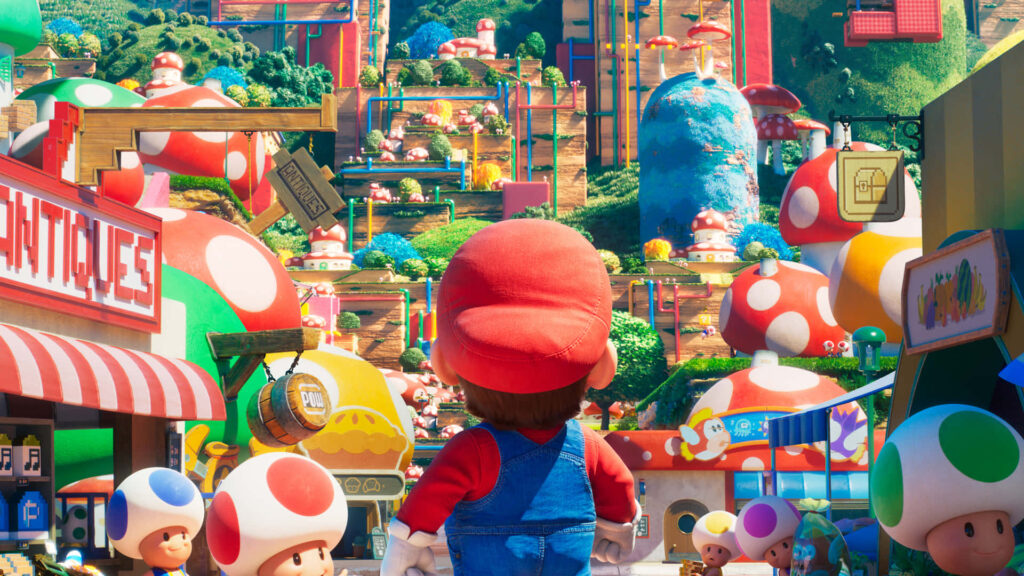
Table of Contents
How To Be More Resilient – Introduction
So I was recently watching the Mario Movie last week, and I realized something while watching it. Mario is one resilient dude. This guy simply never gives up. Not even his own family believes in him? He didn’t give up. His brother got abducted by a maniac fire breathing turtle? Still didn’t give up. Was getting owned in a fight by Donkey Kong? Nope not giving up. I could list way more examples but we would be here all day. Point is: this dude never quits.
And while watching this, I realized something. I want to be more like him. I want to have the will of iron that he has. And that’s when I had a thought: “What if I do a guide on resilience?”. I thought it was a pretty good idea. Resilience is such an important trait to have, but it’s not an easy one build up either. Many people struggle with it as well, lots of people tend to give up on things pretty quickly. So basically, it’s perfect guide material.
It’s obviously not just about having something to write about though. It’s like I just said, resilience is such a great trait to have. This is because of one simple fact: Only the resilient are successful. Throughout your self improvement journey (or just your life in general), you’ll encounter many hardships. Only through resilience will you be able to overcome these hardships. Only through resilience will you be able to keep going when everything is telling you to stop.
Now what do you say we dive straight into it? Let’s start with the usual.
Understanding Resilience – What Makes a Man

If you want to be successful at something, you need to understand how it works. If you want to go viral, you need to understand how algorithms work; if you want to get into bodybuilding, you’ll need to understand how lifting and dieting work; if you want to get good at a game, you’ll need to understand how that game works. You get the idea.
With resilience, it’s no different. If you want to be resilient, you need to understand how resilience works, you need to understand what makes someone a resilient person. You’ll need to understand the traits they possess along with their mindset as well as their general attitude toward life. So let’s go over exactly that, and dive deep into the mindset of those who simply don’t quit.
Resilience Defined
I know I know this may not seem that important to you, but just wait a second. In order to better understand resilience, it’s better that we’re on the same page when it comes to what it actually is. To do that, we need a definition that we can keep in mind when going over the rest of the points. So without further ado, let’s a go! What? You seriously thought I wasn’t gonna include a Mario pun?
Resilience is the capacity to endure, adapt and grow through difficult circumstances. It’s about facing life’s hardships head on without ever backing down and giving in. It’s about staying consistent every single day even when you aren’t seeing any success. It’s about always getting back up no matter how many times you get knocked down. Resilience isn’t just a trait, it’s a way of life.
So there, that’s what I see as resilience. Now that we’re on the same page, let’s dive into what makes someone resilient.
The Growth Mindset

At the core of resilience lies a growth mindset, one of the greatest mindsets that you can possibly have. So what is this mindset exactly? Well, this entire mindset revolves around one simple belief: the belief that abilities, traits and intelligence can be earned through hard work and dedication. Of course it’s way more complex and elaborate than just that one belief, but that’s the very heart of the mindset. Every single aspect of this mindset revolves around that one belief, so make sure you adopt that belief yourself. Now let’s take apart this mindset.
Growth Mindset vs Fixed Mindset
Like I just established, the core belief that serves as the foundation of this mindset is that belief that traits are not inherent, and they can be earned through hard work and dedication. If you don’t believe this, then you’ll never be able to adopt a growth mindset. People who don’t have this mindset usually believe the exact opposite of what the growth mindset believes. They believe that traits and intelligence are purely inherent. They believe that if you’re not born intelligent, then you will never be intelligent in your life. The severity of these beliefs can vary, with some getting so bad that they believe that people are either born with or without talent.
This is the kind of mindset that incels and nihilists have, although not everyone who has this mindset falls under that category so make sure to keep that in mind. Nevertheless, you won’t get far in life if you adopt this fixed mindset (there’s probably another name for it but I’m going with this). To illustrate this, I’m gonna use another one of the core beliefs of the growth mindset.
This is the belief that our mind is our greatest strength, but it is also our biggest weakness. Our mind is often the reason we succeed, but it can also be the reason we fail. Why is this the case though? Simple, the power of belief. I know that may sound a little corny because this point always shows up in TV and movies, but it’s true. If you believe you can’t do something, then you have no chance of doing it. You’re imposing limitations upon yourself. However, if you reverse this belief and you genuinely believe that you can achieve whatever you want to achieve, then there’s a high chance you’ll do it.
The growth mindset thrives off the belief that we can achieve our dreams and that we can do it. Now let’s take a look at what a person with each mindset will do when chasing their dreams. When chasing your goals, you’ll naturally encounter many hardships and setbacks. A person with a fixed mindset will fail in the face of these hardships, and then give up because they think they’re not good enough to achieve their dreams. A person with a growth mindset will likely fail too, but the key difference is that they’ll see this failure as an opportunity to grow and be better.
And with that, my point has been made.
Embracing Challenges as Opportunities
In the growth mindset, challenges are viewed as opportunities. You may be wondering “Opportunities to what exactly?”, and I have you covered. Challenges are viewed as opportunities to learn, grow and prove oneself. They’re also faced head on with true resilience. I would elaborate further on this but I doubt that would be very engaging. So instead, I’m gonna use one of the most common excuses as an example of why this belief is so important.
I brought this excuse up in a guide a couple months ago and now it’s back again to make its no so grand return. I’m sure you’re wondering what it is, and I’m willing to bet that you have heard it many times before, so let’s get on with the big reveal. This excuse is “It’s too hard.” Yep, you read that right, that’s the excuse. I hear it all the time and from so many different people.
The people who make this excuse all have one thing in common too: they refuse to take action. Whether it be quitting an addiction,overcoming mental health issues, or chasing their dreams; their response is always the same. “It’s too hard.” It’s their go to excuse when they encounter any form of challenge and they cling to it like they’re holding on for life.
These people all fail to understand one simple thing though. They don’t understand that life without challenge is dull and boring. If you avoid everything that you consider to be hard, then you’ll never get anywhere in life, you’ll never grow as a person. When you embrace a growth mindset, you have to embrace challenges too. They’re a perfect chance become stronger, more resilient, and more disciplined too. So embrace challenges, embrace the growth mindset. God that sounds like an ad for an energy drink.
Learning From failure and Setbacks
The next key belief of the growth mindset is all about failure. The growth mindset views failure through a positive angle. That’s right, the growth mindset views failure as a learning opportunity. I know half of you are on board with this idea while the other half probably thinks I’m crazy. If you’re one of those people, just hear me out.
It’s no surprise that failure sucks. It’s an uncomfortable feeling that no one wants to feel. It sucks to feel like you’re not good enough, and that’s exactly how failure makes you feel. This often causes people to try their hardest to avoid failure. And what’s the easiest way to do this? Not try. If you think and act like this, then things have to change. If you don’t change things, then you’ll probably live a pretty unsatisfying life.
So how do you change things? The first step you must take is to be aware of one important fact: failure is inevitable. It may be a little uncomfortable to hear this but it will do a lot of good. No matter how hard you try you’ll never be able to avoid failure. that’s why you should stop avoiding it and start embracing it. Even if it’s uncomfortable, it’s the right thing to do.
Now for the second step. The second step is to start extracting lessons from each of your failures and learning from them. By doing this, you’ll be constantly improving and looking to be a better version of yourself. That being said, it’s not exactly easy. It can be hard to face your wrongdoings. It’s just such an uncomfortable feeling, which makes averting your eyes all the more easier. However, the previous section taught us exactly why we should not do that. Just because it’s hard doesn’t mean you shouldn’t do it. In fact, it gives you all the more reason to do it. Plus, you’ll be showing true resilience.
So don’t avert your eyes from your own failings, face them head on and use them as valuable lessons. I know it’s not ideal to face your failings but you may as well make the most out of a bad situation so you can turn it into a good one.
The Role of Effort and Persistence
The growth mindset values hard work and persistence a lot. I mean that’s kind of obvious though, since pretty much all personal growth is achieved through these means. And since the growth mindset mainly revolves around personal growth, it makes sense that it would value it so much. Now let’s take a look at why these two aspects are so important to the mindset.
First up is hard work and effort. Someone with a growth mindset works hard every single day of their life. They take no days off and they’re dedicated to improve. they don’t even care how they feel, they’ll still put in the work that they must do to improve. On top of that, they also put maximum effort into this work. They always give it their all. they work with passion and conviction, holding hope in their heart. Wouldn’t it be awesome for you to be like this too?
Now let’s compare this to how someone with a fixed mindset approaches hard work. People with a fixed mindset will feel all pumped up to start working toward their dreams. They’ll be fueled by the spike of dopamine that we all get when starting out on the path to achieve our goals. However, this dopamine spike does not last. They’ll then get bored and not feel like doing it anymore.
This is where people with a fixed mindset and people with a growth mindset differ. The person with the fixed mindset will probably try and find some excuse to stop working, they’ll think that they’re not cut out for it and just give up. Someone with a growth mindset would never do this. What would they do though? Well the answer to that lies in the next aspect…
You probably know the answer already, they would keep working regardless of how they feel. They would stay persistent and resilient even if they don’t feel like doing the work. A common misconception people have about successful people is that they’re always motivated. The people who think this then go out and try and find ways to always stay motivated as that way they’ll actually feel like doing the work they know they should do.
However, this belief is false. Motivation doesn’t last from anyone, it comes and goes like the wind. the difference between successful and unsuccessful people is that successful people still do the work regardless of their motivation levels. They’re disciplined and persistent, they put what they want in life before what they want right now.
To achieve a growth mindset, not only will you have to think like these people; but you’ll also have to act like them too.
Cultivating a Growth Mindset
Ok so I’ve been talking about the growth mindset a lot but I haven’t actually touched on how to adopt it, so let’s do exactly that. The first thing you have to do is challenge your fixed beliefs. These beliefs usually are beliefs along the lines of “I’ll never be good enough to achieve my dreams.” You know, those kinds of beliefs. You need to challenge them and tell them that you are good enough. It’s also important to recognize the fact that no one is perfect. Why though? Well by acknowledging this, you’re also acknowledging your limitless potential, so don’t waste it.
Changing your way of thinking and correcting your thoughts is the first step you have to take to attain a growth mindset. What’s the next step though? That next step is outlined in the final paragraph in the previous section: you have to start acting like someone who has a growth mindset. This means that you have to work hard every single day, you have to stay persistent when things get tough, and you have to approach life with a positive and open-minded attitude.
You have to understand that adopting the beliefs of a mindset is not adopting the mindset. Your beliefs don’t mean anything if your actions don’t reflect them. If you don’t take action, then you’ll just come off as someone who is all bark no bite. Remember that only you know what you’re thinking and what you believe, so others will just judge your by your actions. And if your actions don’t back up what you’re saying, then that isn’t exactly the best of looks. Do you seriously want to be one of those people.
Growth Mindset – Conclusion
Well that should be about it for the growth mindset, I know it’s been a pretty long section, but a growth mindset is key to cultivating resilience. To be resilient, you need to have a strong mindset that will help you to keep going, and the growth mindset is the perfect one for the job. It helps you to understand that you can get better and that you can improve. It helps you make the best out of bad situations. It helps you be better.
Emotional Intelligence

Another key quality that resilient people possess is emotional intelligence. This is a special kind of intelligence that has little to do with academic intelligence. For those who don’t know, emotional intelligence is the ability to understand, use and manage your own emotions. It also involves perceiving, recognizing and influencing the emotions. So basically, it’s all about reading the room. It’s a lot deeper than just that though, which is why I’ll be doing what I did for the growth mindset and diving into the qualities of someone with this mindset. Let’s do this.
Self-Awareness
This one is kind of a given, but it’s also one of the core components of emotional intelligence so I can’t not mention it. After all, you can’t understand your emotions if you don’t understand yourself. It’s also just better to be aware of how you operate as a person, so let’s break down self-awareness.
Self-awareness is all about understanding every single aspect of yourself. This includes basic stuff like your personality, your interests and your values. But it also goes a lot deeper than that. It also includes being aware of your emotional triggers, your mental issues and even your darker side. That’s right, your darker side, the side of you that you may or may not turn a blind eye to and pretend it doesn’t exist. Let’s go a little deeper into this.
I want you to remember something important, only being aware of what you want to be aware of isn’t self awareness. It’s actually the opposite. One of the core components of being resilient is facing uncomfortable truths head on, and accepting them regardless of how they make you feel. This means that you should take time to face yourself and your darker side. When doing this, remember that everyone has darkness within them. No one is perfect after all. But you can improve, anyone can. With hard work and persistence, you can overcome any darkness.
Now let’s look at how someone who isn’t self-aware operates, so you can see how important it is to emotional intelligence. Someone who isn’t self-aware naturally doesn’t understand themself very well. They may feel certain emotions and not understand why they’re feeling that way. They may have many bad or harmful impulses and not know why they’re having them. They may even come face to face with their darker side and make up an excuse for it or pretend it’s not a part of them. All this because they don’t understand their own emotions, which means that they’ll never be emotionally intelligent in their current state. So make sure to learn from their mistakes.
If you want to learn more about self-awareness and how you can become more self-aware, the make sure to check out my Self-Esteem Guide, it’s worth a read.
Emotional Regulation
Emotional regulation is honestly not talked about enough, despite it being such an important aspect of emotional intelligence. So let’s talk about it a little bit. Emotional regulation is all about managing your emotions. Someone who is good at it is able to handle stress, not let themself spiral into a negative state, control their impulses and stay calm in tense situations. It can be such a useful skill to have (plus it’ll also make you more resilient), so let’s dive a little deeper into it.
You were probably amazed at what emotional regulation can do when reading the previous paragraph. I bet you even wondered how people are even able to do that. Well guess what? That’s exactly what we’re going over. The key to emotional regulation lies in one specific place, your mind. Once you understand that, then there’s a few steps you must take.
The first step is to become fully self-aware (better read that Self-Esteem Guide). In order to be able to regulate your emotions, you’ll need to be able to understand them first. This will help you for the next step, which is to recognize when you’re feeling certain emotions. By recognizing your emotions, you’re taking a huge step toward managing them. The final step is to not let the emotions get to you (I’m saying the word emotions way too much). This step may involve resisting an impulse, staying calm in a stressful situation or stopping yourself from spiraling into negative thoughts. To illustrate this process. I’m gonna provide you with an example.
The example I have chosen is emotional regulation to help quit vaping, let’s go. So the first step is being fully self-aware and I bet you’re wondering how this helps to quit vaping. Well you know how many vapers refuse to admit they’re addicted? They’ll always say stuff like “Oh I can just quit whenever so I’ll quit when it gets boring.” I think we can all agree that this is bluff, they’re just trying to feel themselves. So they’ll need to become fully self aware and accept that they’re addicted. Once they’ve done that, they can move onto the next step.
So step 2 was recognizing when you’re feeling certain emotions. For vapers, this would be recognizing when they get the urge to vape. By doing this, they won’t just immediately give into their impulsive desire to have a quick puff. Instead, they’re giving themselves a chance to beat the urge.
The final step was to regulate the emotions and not let them get to you. For vapers, this will be as simple as not going out and buying a vape (I would say not picking their vape up but anyone who is serious about quitting just throws their vapes away). By resisting this impulse, they’re taking a huge stride toward quitting. They’re building emotional regulation, and most importantly: resilience. Yeah, you’ll become so much more resilient by leaving behind your bad habits. Just remember that it takes a lot of persistence to leave behind these bad habits and master emotional regulation. But you go this, so go and show your resilience.
Empathy and Social Skills
Another trait of emotional intelligence is empathy, as well as good social skills. You basically have to be empathetic to be emotionally intelligent. Empathy is all about understanding and resonating with the emotions of others, a huge part of emotional intelligence is all about understanding how other people operate, reading the room, and knowing how certain actions would make others feel. It’s no coincidence that the two are so closely connected. How does this relate to resilience though? Let’s find out.
There’s one important thing that I want you to remember about resilience. Being resilient isn’t just about not giving up with your own issues, it’s also about not giving up on others. It’s about helping people through rough patches or helping them fix their mistakes. That last one is especially important. Many people only judge others by their mistakes. It’s easier to do that then actually talk to them and figure out what’s going on. Of course I understand that some mistakes are unforgivable, there’s a line that shouldn’t be crossed after all. But that doesn’t change that fact that many people are judged for mistakes that any of us could make, let’s dive a little deeper into it.
So let’s say someone you know makes a mistake. Imagine the mistake they make is something along the lines of lying to others. Most people in your social circle will be quick to call them a snake or a liar or a horrible person. It’s usually like this in most social circles. As soon as people hear about one mistake or bad thing that someone has done, they’re quick to write them off as a bad person. This is showing no empathy and emotional intelligence at all.
You can’t just judge people like that. Although many people do, probably because they get a kick of it, they probably get an ego boost from doing it. It’s kind of like a guilty pleasure for many. But you can’t do this, it shows no emotional intelligence at all. Instead, you have to show empathy. Because the person who made the mistake is still human, they’re not some evil scum of the earth with no morality at all. That’s what some people struggle to remember, instead choosing to talk about them like they’re monsters while acting like they have never made a similar mistake in their life.
So what’s the lesson here? Never judge others or their actions at face value. This is key for becoming more empathetic, since empathy is all about relating to others and their emotions. I know that some mistakes are unforgivable but for many others, there’s always an underlying story. Speaking of that, it’s also important to remember that you never know the full story of others, so keep that in mind too.
Now before we move on, I need to talk a little bit about social skills. You can’t really put empathy to use without social skills after all. Pretty much every emotionally intelligent person has good social skills. they know what to say and they know when to say it. They know how to get people to like them and they know how to influence others. I bet you want to know how to improve your social skills though, well…
The thing with social skills is that people are always looking for cheap tricks on how to improve them. I prefer a more direct approach though. The best way to improve your social skills is by talking to people, a lot of people. By talking to all kinds of different people, you’ll gain so much experience and insight into how people work. Plus, you’ll meet so many awesome people and make many memories too. You just have to be willing to put yourself out there.
Critical thinking
To wrap up this list of traits, we’ll be going over anther extremely valuable and useful skill that is common within the emotionally intelligent: critical thinking. This skill are especially great for cultivating resilience too, since critical thinking allows you to tackle your issues from multiple angles. Now let’s stop wasting time and get into things like usual. Let’s take a look at how emotionally intelligent people use this skill to their advantage.
Contrary to what you may be assuming, I’m going to go over critical thinking first. This is because critical thinking is heavily used in problem solving, so I felt it was more appropriate you know? So as you may know, critical thinking is the act of analyzing a situation objectively and logically in order top come to a conclusion. It’s essentially the most clear form of thinking, the complete opposite of emotional thinking. Emotional thinking is an extremely dangerous way of thinking. Someone who thinks emotionally acts purely on impulses, and doesn’t base their thinking in logic at all. They’re basically loose cannons. If you think emotionally; you’ll never be emotionally intelligent, kind of ironic huh?
I’m sure you noticed that similar topics were coming up ion the previous section (good eye by the way). This is because showing empathy and relating to other peoples struggles does require some critical thinking, and so does being emotionally intelligent (hence why I included it here). If you want to be more emotionally intelligent, you have to think more critically about many different aspects of your life. Since I’m relating this back to resilience, one of those aspects of your life are your personal issues. A lot of the time, thinking about our issues logically and critically will help us reach solutions that much easier.
Emotional intelligence just gets more incredible the more I think about it. Now, I have one last section for this topic left…
How To Be More Emotionally Intelligent
Now that you’ve been endlessly lectured by me about all the traits of emotionally intelligent people, why don’t we put all that new knowledge int practice? Becoming more emotionally intelligent will help you out so much after all, especially with resilience, so let’s get started.
First of all, you’ll want to study the traits I mentioned in this section. This involves re-reading them to make sure you catch every last detail. Further research into the topic will also help too. I know it kind of seems like a chore at times, but at the end of the day, it’s worth it for the sake of learning and growing as a person. Don’t just try and get it over and done with either. You should take your time with your research. Try and find as many different perspectives on these topics as possible, that way you can understand them better. Make some notes too, that’ll help for sure.
While research is great, just doing research will get you nowhere. Sure you’ll understand how emotional intelligence works, but you’ll never actually be able to become emotionally intelligent. To do that, you need real experience, like how i mentioned in an earlier section. Nothing beats raw experience, especially when it comes to a social skill like emotional intelligence.
The best way to become emotionally intelligent is to put yourself into situations that require emotional intelligence. That way you’ll be able to put all this reading and research to good use. You can even put it to use in normal social situations. You can do this by thinking critically about things you otherwise wouldn’t think too deep about. Things like why people talk or act the way they do or you could even think about everything you’re going to say and try and predict how it may make others feel.
So to sum it up, nothing beats true experience. You have to be willing to put yourself out there and into all types of new situations to be able to put all this new knowledge into action, and I know you’ll be great at it. For now, it’s onto the next section.
Adaptability and Flexibility

Another key trait of the resilient is how adaptable and flexible they are. Being resilient doesn’t just mean walking the same path no matter how hard it gets to do so. In fact, that’s only one small part of resilience. Sometimes resilience is about completely switching lanes, while still headed in the same direction. That means switching plans while still chasing the same goals, something that resilient people are very good at. Whenever they’re faced with a new scenario or challenge, they’re quick to adjust to it.
This adaptability and flexibility likely comes from their desire to do anything to keep going. Resilient people are always listen to new ideas if it means coming one step closer to achieving their goals. It’s honestly pretty impressive how dedicated they are to their goals. I guess that’s what makes them so adaptable and flexible, well at least part of what makes them so adaptable and flexible. Speaking of that, I guess we should dive a little deeper into the traits that makes resilient people so adaptable and flexible.
Embracing Change
One thing that pretty much all resilient people have in common is the way they view change. The resilient view change in a positive manner, they accept it as a natural part of life and try to make the most out of it. This is such a good mindset to have, I seriously can’t stress it enough. I know i say that a lot, but like seriously, it’s a golden mindset to have. To prove this to you, I think it’s time for some personal lore.
What feels like a lifetime ago at this point, I used to despise change. I couldn’t stand it whatsoever. I was just a kid mind you, but that doesn’t change the fact that I wanted everything to just stay the same forever. But despite what I wanted, everything changed. My parents announced that we would be moving country. You heard that right, we would be moving country. I was only 9 years old at the time too and I only knew 2 words from that country’s language. Safe to say, I was not happy with this. I protested to my parents more than a – actually scratch that I’m not getting cancelled that easily. you get the idea though.
So do you think that my parents listened to me? Of course they didn’t I was 9. So later that year, we ended up moving country. At first, I felt totally out of place. All I could think about is how much I wanted things to go back to how they used to be. I felt uncomfortable with the constant change in my life. I didn’t really like the new neighborhood I lived in, I wasn’t a fan of the climate, and I felt like an outcast.
The school I attended was a pretty strange school too. It taught English subjects as well as subjects from my new country. So, despite not being English by blood, all my classmates still spoke it. They were extremely friendly to me though. They probably understood the situation I was in. That or they were interested in me, actually maybe both. Regardless of why, they always made sure I was never left out, they stuck by me and did their best to make me feel welcome.
Sadly though, this didn’t make me feel any better. I still felt extremely uncomfortable living there. it didn’t help when I saw how well my sister was learning the new language. I just couldn’t deal with all the change. To top it all off, we were moving house again. I was just so fed up with all the change.
Little did I know though, this change was exactly what I needed. In my new neighborhood, there were many kids my age. My mom said that I should go make friends with them. But my skills with the country’s language were not good enough. That’s when she gave me a speech all about embracing change. To sum it up, she told me that change is inevitable, so I should see the move as an opportunity and make the most out of it. That speech changed everything for me, and I managed to make friends with those kids. I’m still friends with them to this day.
So now, I don’t hate change at all. I look forward to it actually. That’s because change is inevitable, so fearing it is essentially pointless. To deny change would be to deny the very essence of life itself. Since change is inevitable, you may as well make the most out of it. See what you can learn from change, see if there are any opportunities in change, see how change can aid your personal growth and help you become more resilient . Whatever change may bring, just make sure you embrace it.
Open-Mindedness
I told you that embracing change was important. Embracing change can alter your life for the better, like how it did for me. I would have never made friends with those guys if it wasn’t for me deciding to embrace change. Do you know what made me decide to embrace change though? That’s right, an open mind.
When it comes to flexibility and adaptability, an open mind is essential. It’s simply impossible to adopt these qualities without an open mind. It’s also impossible to become resilient without an open mind. Yeah, it’s that important (I say that too much, for good reason though). It doesn’t just help with resilience though, an open mind can help you achieve many different qualities, so let’s go over exactly how and why it’s so important.
To establish why it’s so important to be open-minded, why don’t we take a look inside the mind of someone who is closed-minded. That way, it’ll hit you harder than if I just stated why something good is good, you know? That way, you’ll be able to understand both sides of the coin better, so let’d get into it.
People who have a closed mind live life on a narrow path. They’re like the younger version of me I described in the previous section, they hate change. They just want to live in accordance to their routine become that’s what is most comfortable to them, so they reject any new opportunities or anything that’s filled with uncertainty. Yeah, they hate uncertainty and I bet you’re wondering why. It’s because uncertain situations lead to uncomfortable feelings, something that closed-minded people avoid like the plague. Actually, all people do that, but those with a closed mind just do it more. Let’s dive a little deeper into this.
As humans, our natural instincts tell us to avoid uncomfortable situations. Our brains naturally seek comfort, which forms our comfort zone which is a mental area where we feel safe and comfortable. Stepping outside this comfort zone leads to feelings of discomfort.
However, our comfort zone is somewhat of a trap. While it does keep us safe, no personal growth will be achieved from staying there all the time. You’ll never achieve the resilience you want to achieve and you’ll never be able to become the best version of yourself. You’ll be trading all your dreams and hopes for safety and comfort. Greatness is never achieved inside your comfort zone.
Closed-minded people cling to the comfort zone like that one ex girlfriend. They’re not open to change or new opportunities, they’re too uncertain for them and they’re too stubborn to change their mind on this view. That’s another common trait among those with a closed mind, stubbornness. This trait is pretty divisive, since it can be a really good to be stubborn, but it can also be a really bad thing. In this case it’s definitely bad though, since these guys won’t budge on their closed mindset, or their views.
That’s right, one of the worst parts of a closed mindset is how it affects your views and beliefs. Someone with a closed mind could be holding onto a belief that’s harming them like a fixed mindset for example (still remember that one?). You could try and persuade them all you like that this belief is limiting them, but trust me when I say that they will not listen. They’re probably too busy going through mental gymnastics trying to craft an excuse for not wanting to change their viewpoint at all. It can even get to the point that they are clearly in the wrong and they still won’t listen. That’s no way to live.
Surely by now you see how limiting a closed mindset can be, you’re literally imposing an average life upon yourself just by adopting this mindset. You’ll never become resilient if you think like that. Instead, embrace open-mindedness. Be open to new challenges, be open to new perspective and be open to change. An open mind is a key that unlocks so many possibilities in life. It’ll help you to become more adaptable, more flexible and definitely more resilient.
Ways to Develop Adaptability and Flexibility
I say its time for a quickfire round of ways to become a more adaptable and more flexible person to end this section off, so let’s just get to it.
The first of these is opening your mind and learning how to embrace change. If you don’t do these 2 things, then I doubt any of the other techniques here will work. So make sure to study up and put in the effort.
The first technique isn’t really a technique at all, it’s more of an attitude. This attitude is the act of staying curious. If something piques your interest, even if it seems totally random, and useless, just think about it or do a little research on it. Try and find answered to the questions you’ve always asked yourself and make sure to show interest in everything you do. By doing this, you’re sharpening your mind. This will make you more adaptable and flexible. Those who are resilient always stay, they’re always looking for new ways to strive forward and become even more persistent.
The next “technique” (yeah I realized I’m stretching the definition of technique a little) is to indulge in many creative activities. These activities usually include music, art and video editing to name a few. You have to be adaptable to be good at these activities, so the better you get the more adaptable you become. Creative activities will grow your resilience too, by pushing you to keep learning when things get tough. They also sharpen your mind quit a lot as well, which is even better.
Another “technique” that I have for you is mindfulness. I talk about it in pretty much every guide because it’s just that useful. For those who aren’t in the loop, mindfulness is the act of bringing your mind into a peaceful state that is fully aware of the present. It’s my personal favorite form of meditation and it helps so much with adaptability and flexibility. It sharpens your mind so well, which can help you bounce back from many types of situations and grow your resilience.
There seems to be a pattern throughout these techniques, you’ve probably noticed that by now. That pattern is that all these techniques help to sharpen your mind. Being adaptable and flexible requires a sharp mind, so I decided to revolve these “techniques” around that idea.
Sharpening your mind is key when it comes to bouncing back from difficult challenges, since you’ll be able to spot opportunities or ways to solve your problems a whole lot easier. Plus, not sharpening your mind enough will just lead to laziness and complacency, two things you should not want to be.
Problem Solving Skills

The final resilience trait that I want to talk about is how good the resilient are at solving problems. Resilient people are very good at this, it’s honestly amazing watching a persistent person break down and solve their problems with such ease. It’s even more amazing when you do it yourself, so why don’t we go over exactly how you can accomplish that?
The Role of Problem Solving in Resilience
First of all, we need to define how becoming better at problem solving will you become a more resilient person. Luckily for us, there are many reasons as to why this is the case. But talking about them all would take forever and this post is already long enough so i have settled with 4 reasons, let’s go.
The first and main reason why problem solving helps with resilience is the fact that better problem solving provides better solutions. Many people give up on their dreams because they simply cam’t think of a solution on how to achieve their goals. They may have tried a few things, failed at them, and then they just threw in the towel. Becoming better at problem solving will erase this issue, since you’ll come up with more and better solutions which will allow you to stay persistent.
The second reason why problem solving skills are good for resilience is that better problem solving provides you with more control over a situation. Resilient people view problems as challenges that they can influence, so they figure out ways to overcome those challenges and they take charge of the issue. This is way better than just doing nothing, since that provides you with no control over the situation, something that we all hate.
The third reason why problem solving helps with persistence is because it reduces stress. Being overwhelmed by negative emotions is one of the most common reasons why people give up on their dreams. They just can’t handle the stress of trying to do all these new things. Resilient people don’t do this, they approach their problems methodically and they break them logically, all while staying as calm as possible. This reduces their stress, allowing them to keep pushing on.
The final reason why problem solving is great for resilience is because of the confidence boost it provides. When we solve difficult problems, we feel good about ourselves, we feel like we’re within reach of greatness. This newly found confidence gives us more power to keep on fighting the tough fight. It helps us to keep going.
The Problem Solving Process
Now that we have established why good problem solving skills help you to become a more resilient person, I say it’s time to discuss the best way you can go about solving your problems. For this section, I’ll be breaking down the mental process of how I personally go about solving my problems. I’m not alone in this though, many other people follow this process. It’s a process that works well, assuming that you don’t rush it and put in the effort you need to put in to make it work. So let’s break this down.
Step 1 – Define the Problem: This one may seem kind of pointless to some of you, but it’s an essential step. By putting the problem into words, you are providing yourself with a solid and concrete challenge that you must overcome. Make sure you clearly define it too, making the details as elaborate as you can. Doing this is so important, since many people have a tendency to oversimplify more complicated issue. This can lead to important details being overlooked and the problem remaining unsolved. Do not forget this vital step.
Step 2 – Break it Down: This step is the reason why it’s so important to define your problem as elaborately as possible. It’s also the reason why some people tend to oversimplify their problems. Let me explain. Complex problems can be pretty overwhelming, especially when try to tackle them head on. This complexity can lead to people either oversimplifying the problem or ducking out of solving the problem altogether. Both actions lead to the same result though – the problem remaining unsolved.
So what should you do instead? Simple, break down the problem into smaller, more manageable components. Doing this will still allow you to approach the problem head on, but with a more methodical and better planned out approach. I know what I’m saying should be obvious, but you would be surprised how many people dive into adversity without any sort of plan at all.
Step 3 – Generate Solutions: Your next step is to take a look at the first smaller problem you identified in the previous step, and brainstorm as many solutions you can think of. And I mean it when I say ‘as many you can think of’. Even if the solutions seem totally unrealistic at first, still write them down, you may come up with a way to make them work. And don’t be like “Oh I can’t think of any.”, are you seriously going to give up that easily? If you keep at it and approach the issue from multiple angles, you will find a way.
Step 4 – Evaluate and Choose: The next step is to evaluate the outcomes and potential consequences of all the solutions you have come up with so you can make a well-calculated choice. You should do a pros and cons list for each solution, and weight them against each other. Make sure to be as thorough as possible, so that way your choice is as accurate as possible.
Final Step – Take Action and Learn From Outcomes: The final step you need to take is to take action and see where the solution takes you. Remember to act with resilience and to see the solutions you have come up with all the way to their conclusions. You should keep one thing in mind though – not everything will go as you predicted. You may encounter some unforeseen circumstances or the solutions may fail for reason you did not predict. Regardless of what happens, make sure you learn from the outcome, you may be able to come up with an improved solution with the knowledge you have gained from this experience.
Whatever the process may hold, make sure to embrace it.
Resilience Techniques

That’s right folks we’re over 8000 words into this guide and we’re finally out of the ‘Understanding Resilience’ section. By now, I’m pretty sure you’re an expert on the main traits that make up the ‘resilience mindset’. All that knowledge won’t do you any good just sitting in your head though, so why don’t we put it to good use?
In this section, I’ll be showing you some mostly practical techniques that you can use to put your newly found knowledge and resilience to good use, so let’s not waste any more time because this post is already long enough.
Facing Uncomfortable Truths
I decided to go with the most important technique first, since being faced with an unfavorable truth is one of the best ways to test your resolve. I’ve been talking about this a lot throughout the guide, and I’m sure you’ve noticed and want to prove your strength by facing the truth and accepting it for what it is.
Luckily for you, we can actually give it a go right now. What? You think I’m joking? No, I’m actually being dead serious. Let’s have you face an uncomfortable truth right now, one that many people fall guilty to.
Throughout this post, I’ve gone into detail comparing people who are resilient to those who aren’t. I’m sure you’ve already recalled a few examples I provided, like the fixed mindset or emotional regulation one. In each of these examples, I highlighted flaws among the people who did not posses the traits in question, and showed how the negative counterpart of the trait in question is actively ruining their life (e.g. I showed how a fixed mindset can impose many limitations on one’s life).
I bet you’re wondering why on earth I brought this up now. Well I did it to ask you one simple question: You got a kick out of reading those parts didn’t you? I bet you felt real good about yourself while reading them, you could say it gave you a sense of superiority. I bet you saw me describing all those negative traits that these people have and you felt like you were better than all of those people. You were probably thinking thoughts along the lines of “Man I’m so much better than them, I would never make the same mistakes.” What? Did I stutter?
I bet you see what I’m getting at now, that is the uncomfortable truth I want you to face. While it is entirely possible that you didn’t think this, I’m willing to bet that a large number of you had similar thoughts. It’s okay though don’t worry, we’ve all been there at some point. You just have to face the truth without turning a blind eye to what you did. This is what you wanted, you can do this.
I also wanted to use this chance to illustrate another point while I have the chance. Those thoughts and feelings of superiority can easily corrupt anyone’s mind. It’s easy to just think that you’ll never think stuff like that, or at least it is until you have a reason to think like that. having those thoughts may even lead to you adopting some of the negative traits I previously described. Your self-awareness could easily become corrupted by this for example.
So what’s my point? My point is that anyone can end up like that people I described. they’re just not inferior beings who will never know better, they’re humans just like you and I. All it takes is a few wrong turns and a lack of caution to start heading down the path they did. It’s so easy to get in over your head and end up like them. Remember – no one thinks stuff like this will happen to them until it actually does.
Develop a Healthy Routine
I known what you may be thinking: What does a healthy routine have to do with resilience? Well it actually does help quite a lot to help you become more resilient. If you have an unhealthy routine, you’ll probably feel tired all the time. If you constantly feel tired, then you won’t have as much energy to persist through your problems. On the contrary, a healthy routine will provide you with the energy you need to stay resilient.
To help your routine improve, I’ll be providing you with tips to improve your morning and night schedules. This will help you to prepare yourself for a day of hard work and also wind down after a long day full of effort.
Let’s start off with your morning routine. Just be aware that I won’t be providing you with an exact routine since everyone is different, just some tips. So what should an ideal morning routine include? Well first tip I would provide would be to actually get up in the morning. There are so many teenagers and young adults who don’t even have a morning routine because they don’t get up in the morning. Some even wake up as late as 2:00PM. So if you are one of those people, then try getting up before noon.
The next tip I would provide would be to not scroll on your phone for hours on end while still sat in bed. That’s just wasted time and it doesn’t exactly put your day off to a flying start. The thing I find ironic about this is that people who scroll in bed don’t want to do it deep down, but they can never escape the trap of picking up their phone every time they wake up. This combined with waking up late will kill all momentum you had for the coming day.
The final tip I have for you is to set a positive tone for the rest of the day. This involves doing things that that will make you feel calm but full of energy. A perfect example of one of these things is meditation, something that I talked about quite a lot in my previous post (it’s a guide about overcoming guilt, pretty cool if you ask me). Back on topic though, meditation is great for setting a positive mood for the rest of the day. Other activities that also set a positive mood include morning walks and some exercise. Make sure to stay consistent too, that’ll also help develop even more resilience.
The nighttime routine is up next and for this one, we’ll be focusing in on ways that you can wind down and get you ready for a good night of sleep. The first thing that I would advise you to do is reduce your screen time during night hours. Looking at at screens right before you go to bed will keep your brain wired and active which is not ideal for going to sleep. It doesn’t end there though, you also won’t rest as well and you may find yourself waking up earlier than intended.
So what can you do instead of looking at screens? Well, you need to find something relaxing to do instead. You know, something that will help you to wind down. Personally, I recommenced stuff like reading, journaling and listening to relaxing music. Certain meditation techniques also help to relax. Being relaxed will help you to fall asleep that much faster and it will also ensure that your rest is uninterrupted.
Specific Measurable Achievable Relevant and Time-Bound Goals
Yeah I know, that is one long title. For the final tip of the entire post we’ll be going over the importance of setting specific measurable achievable relevant and time-bound goals, or SMART goals for short.
You know how we all have those big goals that are like the ultimate things that we want to achieve in life? SMART goals are not those types of goals. So what are they? SMART goals are more like short term goals that are designed to help you reach milestones and move toward your bigger goals. Of course though, they also play a huge role in helping you become more resilient. This is a resilience guide after all you know, almost everything I mention here will help you to be more persistent. Back to SMART goals though, I’ll be going over exactly how you can set great goals using every letter of the acronym.
First up, your goals have to be specific. Our big, ultimate goals tend to be very general. SMART goals do not. They usually revolve around a specific task that will help you move closer to your ultimate goals. Examples of this would be completing YouTube videos or reaching a certain amount of followers.
Next up, your goals have to be measurable. This builds nicely off the previous one so I won’t actually have to do much explaining. For stuff like reaching a certain amount of followers, what you’re measuring should be obvious. For stuff like YouTube videos or similar projects, you should be measuring on quality. Make sure not to be biased though.
The next step is to make sure that your goals are achievable. The most important part about this step is to strike a balance between making your SMART goals achievable but also making them challenging enough to test your resilience. Making them too achievable doesn’t provide any challenge and it won’t test your persistence at all.
You also need to remember to make your goals relevant? Relevant to what though? Relevant to your ultimate goals and dreams that’s what. If they’re not related to that, then what’s the point in doing them?
The final thing you need to make sure of is that your goals are time-bound. By providing yourself with a time limit, you’re pushing yourself even further, you’re showing more resilience.
That’s it for SMART goals, pretty good aren’t they? That’s also it for the entire guide, so to the conclusion we go.
How To Be More Resilient – Conclusion
And that’s a wrap for another SMM self-improvement guide. I’m sure you noticed that the majority of the guide is focused around the resilience mindset and I assure you that this is no fluke. The most important part of becoming more resilient is adopting a resilience-based mindset. Without that, you will never be resilient.
I know it’s not exactly easy though, many self-restricting beliefs we have don’t tend to go away easily. Nonetheless, it’s still worth taking those beliefs down. It’s worth it so you can grow and be better. Now to end this, I want you to remember one quote:
It may not be an easy fight, but it’s a fight worth fighting – Every resilient person ever



